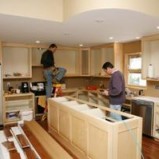
How to Update Your Home, Part 3
Posted on Jan 8, 2014 in Blog, Home Renovation | 0 comments
First…a point of caution.
Although we are big proponents of “sweat equity”, certain jobs require professionals. As a general rule of thumb, if the project requires a skill that normally requires a license or certification, such as electrical, plumbing, HVAC, or structural, it is normally best to hire professionals. Obviously we’re talking about more extensive work than just changing a light switch cover or toilet float. If you try and do the extensive re-work yourself, you’ll likely end up hiring a professional later, thus eliminating any money you may have saved.
So what kind of projects should you focus on? Historically, kitchens and bathrooms offer the highest return on your investment, so we usually advise clients to look there first.
Also, remodels that increase square footage increase the value of your home, so finishing a basement or attic space could add significant value to your property. As we alluded to earlier, all upgrades are not created equally–investing $10,000 on new kitchen countertops will go much farther than $10,000 worth of landscaping in the backyard.
Kitchen and bathroom upgrades don’t necessarily have to cost a small fortune. Old, worn-out cabinets can absolutely be transformed by being sanded down, re-painted or stained, and new hardware installed. We recently remodeled an entire kitchen for less than $1300 ($700 tile floor, refinished cabinets for $75 in sandpaper and hardware, $400 oven/stove, $75 paint). That new kitchen yielded us over $10,000 in profit on that investment.
Bathrooms are often overlooked, but can be critical to a home selling. Back when your author was young and single, he bought a house that was absolutely perfect for him—unfortunately it was far from perfect for most of the potential buyers, because the master bath was extremely small! Now increasing the size of the bathroom would have been impossible, or at least very expensive with having to build new walls, move plumbing, etc…Instead, we replaced the old, bulky vanity with a very stylish pedestal sink, changed the flooring, shower hardware, and mirrors. It wasn’t perfect, but for about $500, it was no longer a negative when showing the house.
Landscaping is a much discussed, and somewhat controversial, upgrade. Most real estate professionals will tell you that there is very little return on investment when it comes to landscaping. However, “curb appeal” is very real—is doesn’t do any good to have the greatest kitchen in the world if no potential buyer ever gets past the front yard to see it! Hiring professionals will cost a significant amount, but doing it yourself can save a lot of money and yield tremendous benefits. Don’t worry about not having any “design talent”. Drive around your neighborhood and look at the other homes with landscaping you like and take ideas from several of them. Be creative and you’d be amazed at what you’ll come up with. Another great benefit from this technique is that your landscaping won’t be “out of place” for the neighborhood.
Most importantly, discuss your improvement ideas with your network real estate agent—that’s what they are paid to do! They see hundreds of homes every month and talk to buyers and sellers constantly…they have the experience, expertise, and insight that will assist you in making the very best decisions you can.
And don’t forget to save all of your receipts—most home repairs and improvements for the purpose of selling your house is a tax deduction (talk to your CPA)!
Good luck with your projects!



